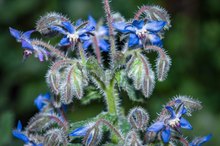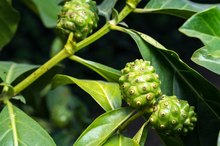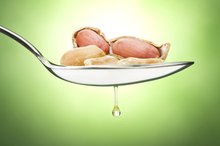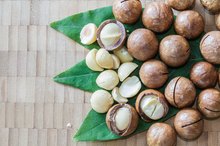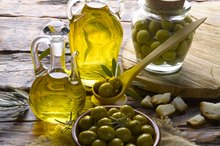Side Effects of Frankincense Oil
Frankincense oil comes from the resin of Boswellia serrata trees. Some aromatherapy oils, perfumes and certain types of incense contain this oil. Ayurvedic medicine, the traditional health care of India, also uses frankincense oil to treat several conditions. In Western medicine, frankincense oil is of interest because of its anti-inflammatory properties, according to the Memorial Sloan-Kettering Cancer Center. Some side effects are possible, but the MSKCC notes that frankincense seems to have fewer negative effects than drugs that treat inflammatory conditions, such as steroids and non-steroidal anti-inflammatory drugs.
Gastrointestinal Side Effects
Gastrointestinal side effects are possible when taking frankincense oil, according to the Physicians' Desktop Reference. They may include an upset stomach, nausea, stomach pain, burning sensations or an unpleasant feeling of fullness. Frankincense oil can also make an upset stomach or stomach pain worse.
Blood-Thinning Effects
How Much Oil Should You Eat?
Learn More
Frankincense oil has blood-thinning effects and can increase the risk of abnormal bleeding, as noted by the University of Maryland Medical Center. This is primarily of concern for people with a bleeding disorder, or anyone taking medications or other herbs with anti-coagulant effects, such as warfarin, heparin, ibuprofen, aspirin or ginkgo biloba. Anyone scheduled for a surgical or dental procedure should stop taking frankincense oil beforehand.
Allergic Reaction
Though rare, some people might experience an allergic reaction to frankincense oil. Signs as listed by Physicians' Desktop Reference include a rash or hives, itchy or swollen skin, difficulty breathing, tightness in the throat or chest, and chest pain. An allergic reaction to frankincense oil should be considered a medical emergency.
Related Articles
References
- Memorial Sloan-Kettering Cancer Center: Boswellia
- Al-yasiry AR, Kiczorowska B. Frankincense--therapeutic properties. Postepy Hig Med Dosw (Online). 2016;70:380-91.
- Ren P, Ren X, Cheng L, Xu L. Frankincense, pine needle and geranium essential oils suppress tumor progression through the regulation of the AMPK/mTOR pathway in breast cancer. Oncol Rep. 2018;39(1):129-137. doi:10.3892/or.2017.6067
- Ni X, Suhail MM, Yang Q, et al. Frankincense essential oil prepared from hydrodistillation of Boswellia sacra gum resins induces human pancreatic cancer cell death in cultures and in a xenograft murine model. BMC Complement Altern Med. 2012;12:253. doi:10.1186/1472-6882-12-253
- Dyer J, Cleary L, Mcneill S, Ragsdale-lowe M, Osland C. The use of aromasticks to help with sleep problems: A patient experience survey. Complement Ther Clin Pract. 2016;22:51-8. doi:10.1016/j.ctcp.2015.12.006
- Liu X, Machado GC, Eyles JP, Ravi V, Hunter DJ. Dietary supplements for treating osteoarthritis: a systematic review and meta-analysis. Br J Sports Med. 2018;52(3):167-175. doi:10.1136/bjsports-2016-097333
- Ammon HP. Boswellic Acids and Their Role in Chronic Inflammatory Diseases. Adv Exp Med Biol. 2016;928:291-327. doi:10.1007/978-3-319-41334-1_13
- U.S. Food & Drug Administration. Aromatherapy. Updated December 5, 2017.
- Mehrzadi S, Tavakolifar B, Huseini HF, Mosavat SH, Heydari M. The Effects of Boswellia serrata Gum Resin on the Blood Glucose and Lipid Profile of Diabetic Patients: A Double-Blind Randomized Placebo-Controlled Clinical Trial. J Evid Based Integr Med. 2018;23:2515690X18772728. doi:10.1177/2515690X18772728
- Dyer J, Cleary L, McNeill S, Ragsdale-Lowe M, Osland C. The use of aromasticks to help with sleep problems: A patient experience survey. Complement Ther Clin Pract. 2016;22:51-8. doi: 10.1016/j.ctcp.2015.12.006
- Dyer J, Cleary L, Ragsdale-Lowe M, McNeill S, Osland C. The use of aromasticks at a cancer centre: a retrospective audit. Complement Ther Clin Pract. 2014;20(4):203-6. doi: 10.1016/j.ctcp.2013.11.006.
- Liu X, Machado GC, Eyles JP, et al. Dietary supplements for treating osteoarthritis: a systematic review and meta-analysis. Br J Sports Med. 2018;52(3):167-175. doi: 10.1136/bjsports-2016-097333.
- Mehrzadi S, Tavakolifar B, Huseini HF, et al. The Effects of Boswellia serrata Gum Resin on the Blood Glucose and Lipid Profile of Diabetic Patients: A Double-Blind Randomized Placebo-Controlled Clinical Trial. J Evid Based Integr Med. 2018;23:2515690X18772728. doi: 10.1177/2515690X18772728.
- Suhail MM, Wu W, Cao A, et al. Boswellia sacra essential oil induces tumor cell-specific apoptosis and suppresses tumor aggressiveness in cultured human breast cancer cells. BMC Complement Altern Med. 2011;11:129. doi: 10.1186/1472-6882-11-129.
Writer Bio
Shelley Moore is a journalist and award-winning short-story writer. She specializes in writing about personal development, health, careers and personal finance. Moore has been published in "Family Circle" magazine and the "Milwaukee Sentinel" newspaper, along with numerous other national and regional magazines, daily and weekly newspapers and corporate publications. She has a Bachelor of Science in psychology.


